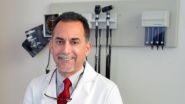(Press-News.org) A genome-wide analysis searching for evidence of long-lived balancing selection—where the evolutionary process acts not to select the single best adaptation but to maintain genetic variation in a population—has uncovered at least six regions of the genome where humans and chimpanzees share the same combination of genetic variants.
The finding, to be published Feb. 14 in the journal Science, suggests that in these regions, human genetic variation dates back to a common ancestor with chimpanzees millions of years ago, before the species split. It also highlights the importance of the dynamic co-evolution of human hosts and their pathogens in maintaining genetic variation.
Balancing selection allows evolution to keep all hereditary options open. The classic human example is the persistence of two versions of the hemoglobin gene: a normal version and hemoglobin S., a mutation that distorts the shape and function of red blood cells. Those who inherit two normal hemoglobin genes are at high risk for malaria, a parasitic disease that infects more than 200 million people each year. Those who inherit one normal gene and one hemoglobin S. gene are partially protected from malaria—a potentially life-saving benefit. Those with two copies of the gene suffer from sickle-cell anemia, a serious and lifelong circulatory disease.
"When we looked for genetic clues pointing to other, more ancient, examples of balancing selection, we found strong evidence for at least six such regions and weaker evidence for another 119—many more than we expected," said study author Molly Przeworski, PhD, professor of human genetics and of ecology and evolution at the University of Chicago.
"We don't yet know what their functions are," she said. None of the six regions codes for a protein. There are clues that they are involved in host-pathogen interactions, "but which pathogens, what immune processes," she said, "we don't know."
The researchers used genetic data from 10 chimpanzees from Western Africa and 59 humans from sub-Saharan Africa who were part of the 1,000 Genomes Project.
The scientists looked for cases in which genetic variations that arose in the ancestor of humans and chimpanzees have been maintained through both lines. The fact that variation in these regions of the genome has persisted for so long argues that they "must have been functionally important over evolutionary time," said Ellen Leffler, a graduate student in Przeworski's laboratory and first author of the study.
The researchers, from the University of Chicago and Oxford University, designed the study to be very conservative. "We wanted to find the cases we believed the most, rather than the most cases," Przeworski said.
Computers sorted snippets of the genetic data from humans and chimps into clusters depending on how similar the subjects were to each other. For almost every snippet, they found a cluster of humans and a separate cluster of chimpanzees, as expected. But there were a few segments of the genomes in which each cluster included both chimpanzees and humans; in those regions, some humans were more closely related to some chimpanzees than to other humans.
"Instances in which natural selection maintains genetic variation in a population over millions of years are thought to be extremely rare," the authors wrote. The oldest and best known example of balanced polymorphism shared between humans and chimpanzees is the major histocompatibility complex (MHC), a group of genes that help the immune system distinguish between the body and potential invaders, such as bacteria or viruses.
Last year, a team led by Przeworski found that humans and gibbons shared genetic variation related to the ABO blood-group system from a common ancestor.
The six new examples of balanced selection described in this study appear to play a role, like the MHC, in fending off infectious disease. This requires a variety of evolutionary tools, including balancing selection. When a population moves to a new environment—for example the exodus out of Africa to northern Europe—they face many one-time adjustments, such as adapting to less intense sunlight and decreased ultraviolet radiation. Over many generations, their offspring manage to decrease melanin production—a static adaptation for a static environment.
Fighting off pathogens is more dynamic, a constant arms race. Balancing selection may have enabled humans and chimps to retain multiple lines of defense that can be called on when a pathogen evolves new weapons.
"Our results imply that dynamic co-evolution of human hosts and their pathogens has played an important role in shaping human variation," Przeworski said. "This highlights the importance of a different kind of selection pressure in human evolution."
###The National Institutes of Health, The Royal Society, the Wellcome Trust and the Howard Hughes Medical Institute funded this study. Additional authors include Ziyue Gao, Laure Segurel and Guy Sella from the University of Chicago; Susanne Pfeifer, Adam Auton, Oliver Venn, Rory Bowden, Peter Donnelly and Gilean McVean from Oxford University; Ronald Bonstrop from the Biomedical Primate Research Centre in the Netherlands; and Jeffrey Wall from the University of California at San Francisco.
Humans and chimps share genetic strategy in battle against pathogens
2013-02-15
ELSE PRESS RELEASES FROM THIS DATE:
Smoking bans linked with 'successive reductions' in preterm birth
2013-02-15
The study supports the notion that smoking bans have public health benefits from early life.
It is well established that smoking during pregnancy impairs the growth of an unborn child and shortens gestation. Exposure to second-hand smoke has also been found to affect birth outcomes, yet little is known about the impact of recent smoke-free legislation on birth weight and preterm birth.
So a team of researchers, lead by Dr Tim Nawrot from Hasselt University, investigated whether recent smoking bans in Belgium were followed by changes in preterm delivery. In Belgium, ...
Study finds strong link between income inequality and readmission risk, but not mortality
2013-02-15
The authors estimate nearly 40,000 extra admissions to hospital as a result of income inequality over the three year study period.
Income inequality is associated with a variety of adverse health outcomes, including higher infant mortality, reduced life expectancy, and poorer self-reported health. But little is known about the possible link between income inequality and outcome after admission to acute care hospitals.
So a team of US researchers examined the association between income inequality and risk of death and readmission within 30 days of discharge from hospital. ...
Tough, light and strong: Lessons from nature could lead to the creation of new materials
2013-02-15
In a sweeping review of the field of bio-inspired engineering and biomimicry in the Feb. 15 issue of the journal Science, two engineers at the University of California, San Diego, identify three characteristics of biological materials that they believe engineers would do well to emulate in man-made materials: light weight, toughness and strength.
Joanna McKittrick and Marc Meyers, from the materials science program at the Jacobs School of Engineering at UC San Diego, examine the three characteristics in a wide range of materials, from spider silk, to lobster and abalone ...
Clues to the mysterious origin of cosmic rays
2013-02-15
In the year 1006 a new star was seen in the southern skies and widely recorded around the world. It was many times brighter than the planet Venus and may even have rivaled the brightness of the Moon. It was so bright at maximum that it cast shadows and it was visible during the day. More recently astronomers have identified the site of this supernova and named it SN 1006. They have also found a glowing and expanding ring of material in the southern constellation of Lupus (The Wolf) that constitutes the remains of the vast explosion.
It has long been suspected that such ...
Slithering towards extinction
2013-02-15
NINETEEN PERCENT of the world's reptiles are estimated to be threatened with extinction, states a paper published today by the Zoological Society of London (ZSL) in conjunction with experts from the IUCN Species Survival Commission (SSC).
The study, printed in the journal of Biological Conservation, is the first of its kind summarising the global conservation status of reptiles. More than 200 world renowned experts assessed the extinction risk of 1,500 randomly selected reptiles from across the globe.
Out of the estimated 19% of reptiles threatened with extinction, ...
Losing hope of a good night's sleep is risk factor for suicide
2013-02-15
AUGUSTA, Ga. – When people lose hope that they will ever get another good night's sleep, they become at high risk for suicide, researchers report.
Insomnia and nightmares, which are often confused and may go hand-in-hand, are known risk factors for suicide but just how they contribute was unknown, said Dr. W. Vaughn McCall, Chair of the Medical College of Georgia Department of Psychiatry and Health Behavior at Georgia Regents University.
The new study reaffirms that link and adds the element of hopelessness about sleep that is independent of other types of hopelessness, ...
Climate scientist Schellnhuber to brief UN Security Council
2013-02-15
It will take place on February 15th at the UN headquarters in New York City. Secretary-General Ban Ki-moon plans to attend.
"With unabated greenhouse-gas emissions, humankind would venture into an uncertain future that is much hotter than ever before in its history – so from a scientist's perspective, climate change is a global risk multiplier," says Schellnhuber, director of PIK and chair of the Scientific Advisory Council on Global Change (WBGU) for the German government. Many millions of people could be affected by severe climate change impacts. They range from sea-level ...
Math helps detect gang-related crime and better allocate police resources
2013-02-15
Philadelphia, PA—Social groups in a population can lend important cues to law enforcement officials, consumer-based services and risk assessors. Social and geographical patterns that provide information about such communities or gangs have been a popular subject for mathematical modeling.
In a paper published last month in the SIAM Journal on Applied Mathematics, authors use police department records about individuals' social and geographical information to determine gang memberships.
Data on social interactions is particularly hard to come by, but in combination ...
Yale study links common chemicals to osteoarthritis
2013-02-15
New Haven, Conn. – A new study has linked exposure to two common perfluorinated chemicals (PFCs) with osteoarthritis. PFCs are used in more than 200 industrial processes and consumer products including certain stain- and water-resistant fabrics, grease-proof paper food containers, personal care products, and other items. Because of their persistence, PFCs have become ubiquitous contaminants of humans and wildlife. The study, published in Environmental Health Perspectives, is the first to look at the associations between perfluorooctanoic acid (PFOA) and perfluorooctanesulfonic ...
Why cells stick: Phenomenon extends longevity of bonds between cells
2013-02-15
Research carried out by scientists at the Georgia Institute of Technology and The University of Manchester has revealed new insights into how cells stick to each other and to other bodily structures, an essential function in the formation of tissue structures and organs. It's thought that abnormalities in their ability to do so play an important role in a broad range of disorders, including cardiovascular disease and cancer.
The study's findings are outlined in the journal Molecular Cell and describe a surprising new aspect of cell adhesion involving the family of cell ...



